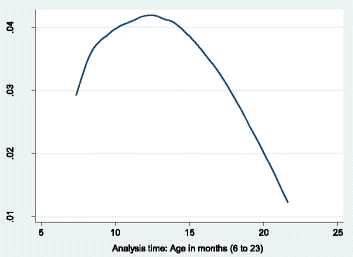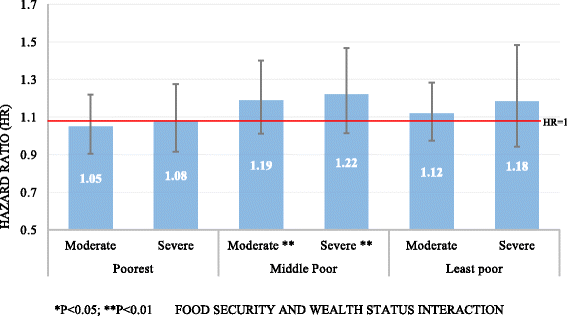Household food (in)security and nutritional status of urban poor children aged 6 to 23 months in Kenya
- PMID: 26463345
- PMCID: PMC4605131
- DOI: 10.1186/s12889-015-2403-0
Household food (in)security and nutritional status of urban poor children aged 6 to 23 months in Kenya
Abstract
Background: Millions of people in low and low middle income countries suffer from extreme hunger and malnutrition. Research on the effect of food insecurity on child nutrition is concentrated in high income settings and has produced mixed results. Moreover, the existing evidence on food security and nutrition in children in low and middle income countries is either cross-sectional and/or is based primarily on rural populations. In this paper, we examine the effect of household food security status and its interaction with household wealth status on stunting among children aged between 6 and 23 months in resource-poor urban setting in Kenya.
Methods: We use longitudinal data collected between 2006 and 2012 from two informal settlements in Nairobi, Kenya. Mothers and their new-borns were recruited into the study at birth and followed prospectively. The analytical sample comprised 6858 children from 6552 households. Household food security was measured as a latent variable derived from a set of questions capturing the main domains of access, availability and affordability. A composite measure of wealth was calculated using asset ownership and amenities. Nutritional status was measured using Height-for-Age (HFA) z-scores. Children whose HFA z-scores were below -2 standard deviation were categorized as stunted. We used Cox regression to analyse the data.
Results: The prevalence of stunting was 49 %. The risk of stunting increased by 12 % among children from food insecure households. When the joint effect of food security and wealth status was assessed, the risk of stunting increased significantly by 19 and 22 % among children from moderately food insecure and severely food insecure households and ranked in the middle poor wealth status. Among the poorest and least poor households, food security was not statistically associated with stunting.
Conclusion: Our results shed light on the joint effect of food security and wealth status on stunting. Study findings underscore the need for social protection policies to reduce the high rates of child malnutrition in the urban informal settlements.
Figures
Similar articles
-
Factors associated with stunting among children according to the level of food insecurity in the household: a cross-sectional study in a rural community of Southeastern Kenya.BMC Public Health. 2015 Apr 30;15:441. doi: 10.1186/s12889-015-1802-6. BMC Public Health. 2015. PMID: 25924925 Free PMC article.
-
Nutritional status of under-five children living in an informal urban settlement in Nairobi, Kenya.J Health Popul Nutr. 2011 Aug;29(4):357-63. doi: 10.3329/jhpn.v29i4.8451. J Health Popul Nutr. 2011. PMID: 21957674 Free PMC article.
-
Household Food Insecurity as a Predictor of Stunted Children and Overweight/Obese Mothers (SCOWT) in Urban Indonesia.Nutrients. 2018 Apr 26;10(5):535. doi: 10.3390/nu10050535. Nutrients. 2018. PMID: 29701632 Free PMC article.
-
Nutritional interventions for preventing stunting in children (birth to 59 months) living in urban slums in low- and middle-income countries (LMIC).Cochrane Database Syst Rev. 2019 Jun 17;6(6):CD011695. doi: 10.1002/14651858.CD011695.pub2. Cochrane Database Syst Rev. 2019. PMID: 31204795 Free PMC article.
-
Community-level interventions for improving access to food in low- and middle-income countries.Cochrane Database Syst Rev. 2020 Aug 5;8(8):CD011504. doi: 10.1002/14651858.CD011504.pub3. Cochrane Database Syst Rev. 2020. PMID: 32761615 Free PMC article.
Cited by
-
Climate-Driven Adaptation, Household Capital, and Nutritional Outcomes among Farmers in Eswatini.Int J Environ Res Public Health. 2019 Oct 23;16(21):4063. doi: 10.3390/ijerph16214063. Int J Environ Res Public Health. 2019. PMID: 31652699 Free PMC article.
-
Predictors of the amount of intake of Ready-To-Use-Therapeutic foods among children in outpatient therapeutic programs in Nairobi, Kenya.Food Sci Nutr. 2022 Jan 18;10(4):1135-1145. doi: 10.1002/fsn3.2745. eCollection 2022 Apr. Food Sci Nutr. 2022. PMID: 35432961 Free PMC article.
-
Social Stratification, Diet Diversity and Malnutrition among Preschoolers: A Survey of Addis Ababa, Ethiopia.Nutrients. 2020 Mar 7;12(3):712. doi: 10.3390/nu12030712. Nutrients. 2020. PMID: 32156006 Free PMC article.
-
Child malnutrition in sub-Saharan Africa: A meta-analysis of demographic and health surveys (2006-2016).PLoS One. 2017 May 11;12(5):e0177338. doi: 10.1371/journal.pone.0177338. eCollection 2017. PLoS One. 2017. PMID: 28494007 Free PMC article.
-
Socioeconomic disparities in child malnutrition: trends, determinants, and policy implications from the Kenya demographic and health survey (2014 - 2022).BMC Public Health. 2025 Jan 24;25(1):295. doi: 10.1186/s12889-024-21037-z. BMC Public Health. 2025. PMID: 39849437 Free PMC article.
References
-
- United Nations Department of Economic and Social Affairs. Sustainable development knowledge platform. 2015. https://sustainabledevelopment.un.org/?menu=1300. Accessed 13 October 2015.
-
- Cook JT, Frank DA, Berkowitz C, Black MM, Casey PH, Cutts DB, et al. Food insecurity is associated with adverse health outcomes among human infants and toddlers. J Nutr. 2004;134(6):1432–8. - PubMed
Publication types
MeSH terms
Grants and funding
LinkOut - more resources
Full Text Sources
Other Literature Sources
Medical




